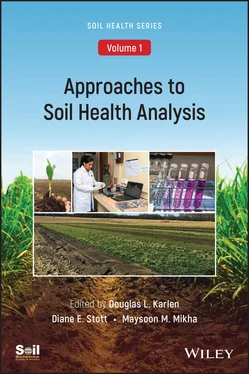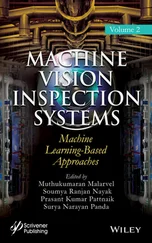Approaches to Soil Health Analysis, Volume 1
Здесь есть возможность читать онлайн «Approaches to Soil Health Analysis, Volume 1» — ознакомительный отрывок электронной книги совершенно бесплатно, а после прочтения отрывка купить полную версию. В некоторых случаях можно слушать аудио, скачать через торрент в формате fb2 и присутствует краткое содержание. Жанр: unrecognised, на английском языке. Описание произведения, (предисловие) а так же отзывы посетителей доступны на портале библиотеки ЛибКат.
- Название:Approaches to Soil Health Analysis, Volume 1
- Автор:
- Жанр:
- Год:неизвестен
- ISBN:нет данных
- Рейтинг книги:3 / 5. Голосов: 1
-
Избранное:Добавить в избранное
- Отзывы:
-
Ваша оценка:
- 60
- 1
- 2
- 3
- 4
- 5
Approaches to Soil Health Analysis, Volume 1: краткое содержание, описание и аннотация
Предлагаем к чтению аннотацию, описание, краткое содержание или предисловие (зависит от того, что написал сам автор книги «Approaches to Soil Health Analysis, Volume 1»). Если вы не нашли необходимую информацию о книге — напишите в комментариях, мы постараемся отыскать её.
A concise survey of soil health analysis and its various techniques and applications Soil Health, Volume One: Approaches to Soil Health Analysis
Approaches to Soil Health Analysis, Volume 1 — читать онлайн ознакомительный отрывок
Ниже представлен текст книги, разбитый по страницам. Система сохранения места последней прочитанной страницы, позволяет с удобством читать онлайн бесплатно книгу «Approaches to Soil Health Analysis, Volume 1», без необходимости каждый раз заново искать на чём Вы остановились. Поставьте закладку, и сможете в любой момент перейти на страницу, на которой закончили чтение.
Интервал:
Закладка:
Utilizing Soil Health Assessments to Inform Soil Management Decisions
It was stated in the Foreword to Doran et al. (1994) that “scientists and lay persons have long recognized that the quality of two great natural resources– air and water– can be degraded by human activity. Unfortunately, few people have considered that the quality of soil can also be affected by differing uses and management practices. Interest in soil quality has heightened during the past 3 yr as a small cadre of soil scientists became more concerned about the role of soils in sustainable production systems and the linkages between soil characteristics and plant‐human health.” This reflects just one early step in the exponential progress made during the past three decades that has led from soil quality being a research niche to broad awareness of the critical importance of healthy soils to agriculture and societies in general.
Soil health considerations are currently being incorporated across the activities of many agriculture‐serving organizations nationally. For example, it has been incorporated into NRCS conservation planning and implementation programs. New soil health resource concerns, or constraints that can be documented by conservation planners, were published (USDA‐NRCS, 2020a). These are also being embedded into key Conservation Practice Standards (USDA‐NRCS, 2020b), a series of documents describing which constraints structural and agronomic conservation management practices can address, as well as the criteria for how to implement these practices to facilitate resolving identified constraints. Guidance is being updated to further reflect the current science on the importance of systems approaches as well, starting with crop lands, with plans to expand guidance available for other land uses. Standardization of measures is being undertaken across multiple organizations to build basic capacity to better inform management decisions and to quantify transition times and outcomes of soil health management systems implementation (USDA‐NRCS, 2019b; Norris et al., 2020).
To fully address resource concerns and build fully functional soils, by improving organic matter quantity or quality, reversing soil organism habitat degradation, alleviating compaction, or improving soil aggregate stability, an agricultural annual cropping system that properly incorporates more than one soil health‐targeted conservation practice is usually needed (Basche & DeLonge, 2017; Congreves et al., 2015; McDaniel et al., 2014; Turmel et al., 2015; USDA‐NRCS, 2019a). Through the NRCS conservation planning process, conservation practices (USDA‐NRCS, 2020b) for cover crops (340), crop rotation (328), and reduced‐ or no‐tillage (345 and 329) are regularly employed by conservation planners to address various resource concerns since the methods of soil and crop management they represent are important contributors to sustainable agricultural production systems. However, if used in isolation, it is unlikely that a single practice will provide lasting SH benefits through improved SOM or the critical soil functions associated with SOM. For example, incorporating a cereal rye cover crop into a two‐crop rotation that is dependent on frequent tillage may provide some weed suppression benefits or help reduce erosion, but it is unlikely that soil aggregate stability will be improved. Realizing improvement in soil function through management changes will typically require the strategic and simultaneous use of multiple practices. To better understand potential interactions among practices it may be helpful to think of their roles with regard to each of four broadly applicable NRCS soil health principles: minimizing soil disturbance, maximizing soil cover, maximizing biodiversity, and maximizing the presence of living roots. Each principle can be implemented using soil and crop management practices designed to address existing soil health concerns and maintain soil function. Depending on the cropping system, each soil health principle can be achieved through appropriate use of one or more conservation practices. Achieving all four principles by thoughtfully implementing and adaptively integrating multiple, complimentary conservation practices known to address identified constraints or concerns is the best way to ensure that soil health constraints are alleviated through synergistic effects as illustrated below.
Minimizing Soil Disturbance
In some cropping systems, physical, chemical, or biological soil disturbance is an inevitable consequence of crop production (Schjønning et al., 2004). However, advances in agronomic research, farm equipment design, and technology have created the potential for most annual cropland acres to be managed with reduced‐ or often no‐tillage practices. Inappropriate use of nutrients and pesticides can also cause soil ecosystem disturbance (Ellert et al., 1997; Frey et al., 1999; West & Post, 2002). Reducing disturbance helps slow carbon losses, minimizes physical destruction of aggregates, and maintains habitat for soil organisms (Larson et al., 1994). In addition to reduced‐ or no‐tillage (345 and 329), Conservation Cover (327), IPM (595), Nutrient Management (590), and Prescribed Grazing (528) can also be implemented to minimize soil disturbance.
Maximizing Soil Cover
Crop residue and other organic materials such as mulch and compost, when they are left on the soil surface, provide a protective barrier between the soil and the destructive force of raindrops. They also moderate extremes in soil temperature and reduce evaporative losses from the soil. Soil cover can also be provided by leaves of growing plants. Keeping the soil covered throughout the year helps maintain soil aggregate integrity, protect habitat and provide food for soil organisms. Conservation practices that can be used to maximize cover include Conservation Cover (327), Cover Crop (340), Forage & Biomass Planting (512), Mulching (484), Prescribed Grazing (528) and Residue/Tillage Management (329/345).
Maximizing Biodiversity
It is well known that crop rotations are an important tool for managing plant pests (Altieri, 1991a, 1991b). What has been less appreciated until recently is that plants, primarily through their roots, affect the kinds and abundance of soil microorganisms, thus influencing soil biology and biological processes (Doran & Zeiss, 2000). Different plant species, and even cultivars, are typically associated with distinct soil microbial communities (Dick, 1997). In addition, since plant root architecture often differs among species, effects on soil function are also different (Brussaard et al., 2004). Above ground plant and animal diversity also encourages diversity in soil biology by increasing SOM levels, providing food and habitat for diverse soil communities, promoting greater aggregate stability, and helping alleviate compaction. Conservation practices that can be used to maximize biodiversity include Conservation Cover (327), Conservation Crop Rotation (328), Cover Crop (340), Forage & Biomass Planting (512), and Prescribed Grazing (528).
Maximizing the Presence of Living Roots
The area around plant roots is typically where the highest number and greatest diversity of soil microorganisms are found (Hornby & Bateman, 1997; Grayston et al., 1998; Ladygina & Hedlund, 2010; Singh et al., 2004). The rhizosphere is a very important ecological zone for SH improvement because living plant roots exude numerous carbon compounds as they grow and steadily slough dead cells from their surfaces. These contributions from roots add organic carbon to the ecosystem and help feed soil organisms. Plant roots are also involved in complex biochemical communication among soil microbes whereby beneficial organisms are “recruited” by plants while pathogenic organisms are often deterred. Plant roots also physically enmesh soil particles thus helping to create and preserve soil aggregates. Conservation practices that can be used to maximize the presence of living roots in the soil include Conservation Cover (327), Conservation Crop Rotation (328), Cover Crop (340), Forage & Biomass Planting (512), Mulching (484) and Prescribed Grazing (528). These selected practices are just some of the ways soil biological processes can be enhanced by SH management systems. Producers and those who work with them on establishing new management adaptations continue to innovate. The remaining chapters provide additional information and examples illustrating how continued implementation of known soil health promoting practices and new innovations can be assessed for their effects on critical soil functions by measuring appropriate SH indicators.
Читать дальшеИнтервал:
Закладка:
Похожие книги на «Approaches to Soil Health Analysis, Volume 1»
Представляем Вашему вниманию похожие книги на «Approaches to Soil Health Analysis, Volume 1» списком для выбора. Мы отобрали схожую по названию и смыслу литературу в надежде предоставить читателям больше вариантов отыскать новые, интересные, ещё непрочитанные произведения.
Обсуждение, отзывы о книге «Approaches to Soil Health Analysis, Volume 1» и просто собственные мнения читателей. Оставьте ваши комментарии, напишите, что Вы думаете о произведении, его смысле или главных героях. Укажите что конкретно понравилось, а что нет, и почему Вы так считаете.












